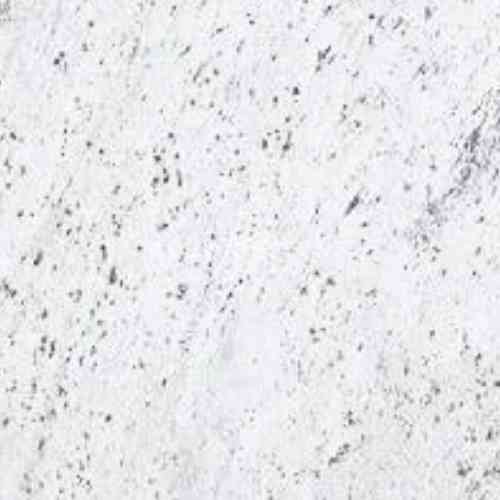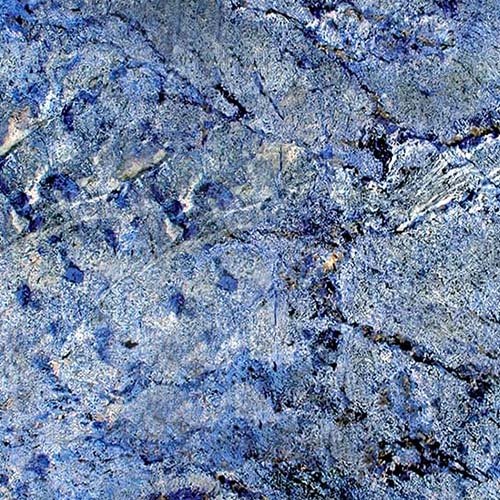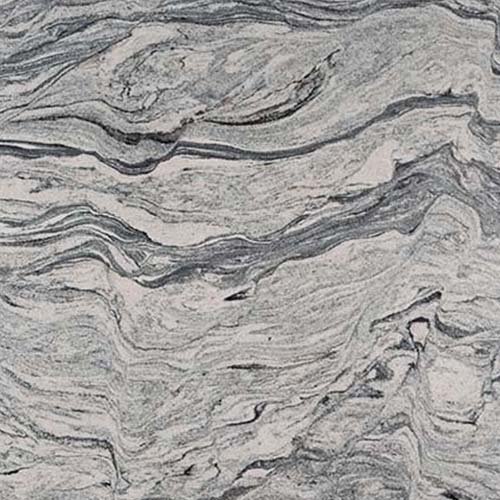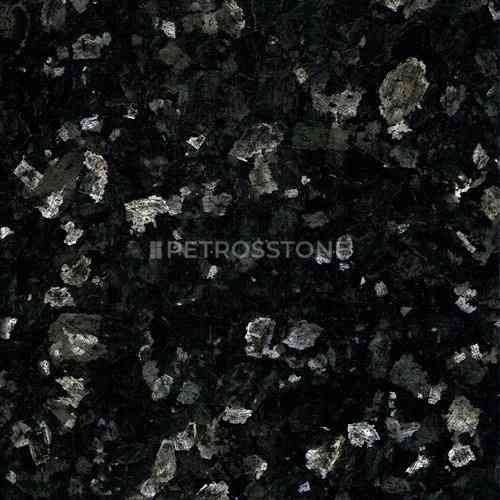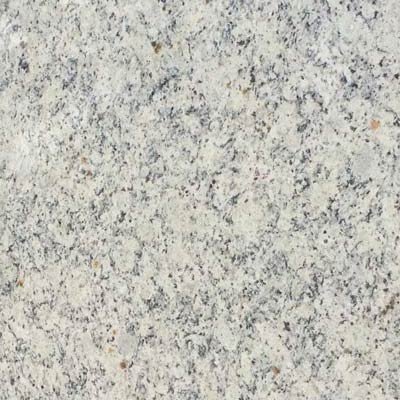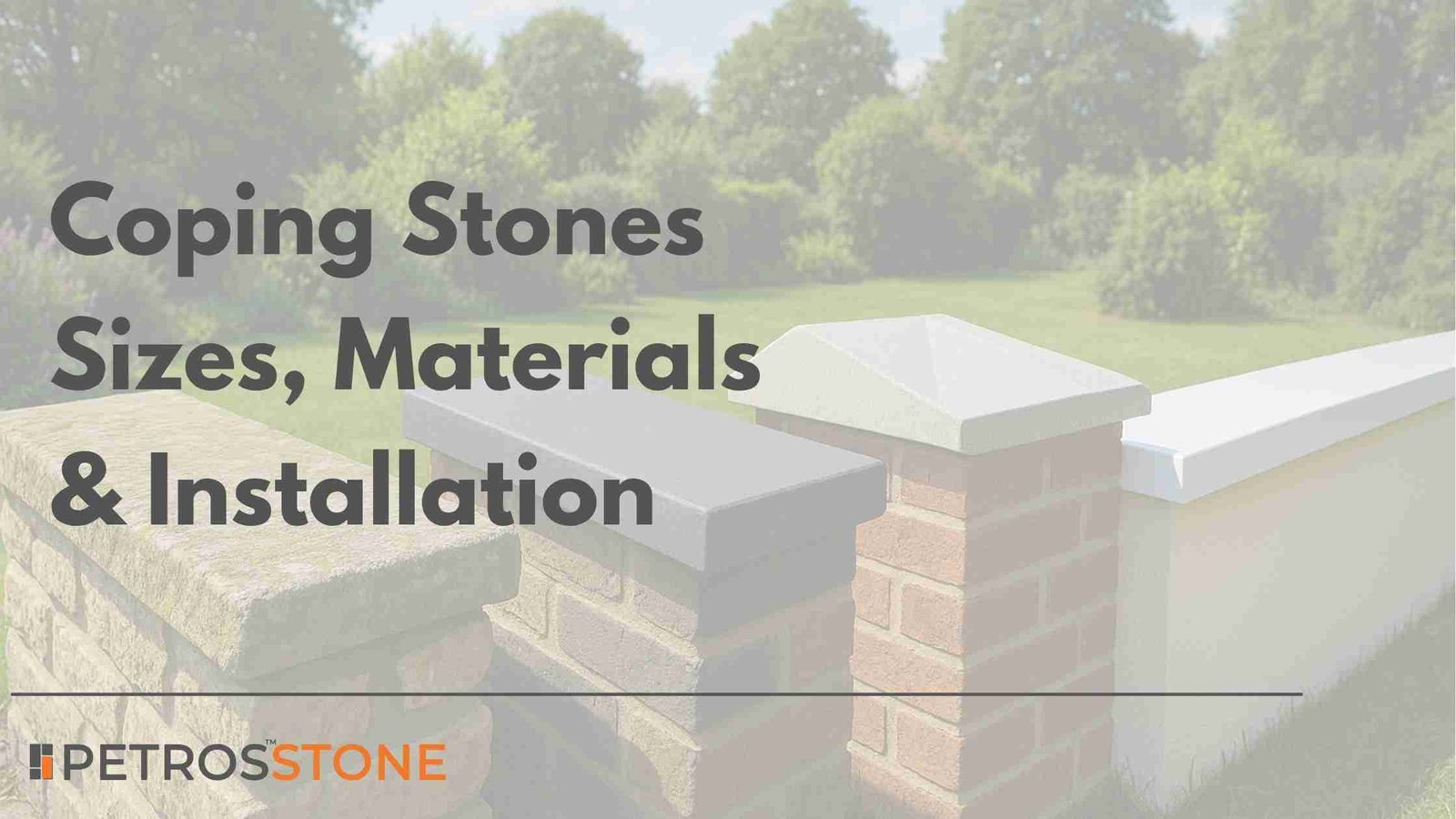
Coping stones are caps that are placed atop walls or other structures. They are usually positioned atop a garden or parapet wall to give the stonework a polished look and protection from weather damage.
There are several types of wall coping stones. This includes brick, concrete, and natural stone. They provide the entire construction with a coherent and cohesive appearance. Coping stones are also frequently combined with other forms of masonry, like bricks or blocks.
Coping stones serve both functional and decorative purposes. However, they can also help stop water from leaking into the wall and damaging it. These wall covers divert rainfall away from the brickwork and prevent it from soaking through the surface.
Purpose
Coping stones are intended for use on flat roofs, garden walls, and parapet walls. They are the wall’s uppermost layer that helps prevent rainwater from seeping through and possibly causing damage to the building. Over time, a wall coping stone preserves the stone bricks’ integrity by protecting the wall from rain and snow.
Usually, coping stones are angled so rainwater can run off them. This minor architectural element lowers the chance of slow erosion by minimizing water infiltration into the wall. It reduces the time and expense of repairs by prolonging the wall’s lifespan.
Types of Coping Stones and their Sizes
Once-Weathered Coping

Once-weathered wall Coping Stones are used to divert water in a particular direction. For instance, an internal gutter must divert water away from the walls to prevent damage as it runs from the roof’s peak towards the inside of the roof.
Using these stones, the top of the brickwork is protected, and water is directed to the appropriate places. For further security, drip grooves can also be put on the sides of gardens, exterior walls, or balustrades.
Once-Weathered Coping Sizes
| STRAIGHT PIECE | OUTSIDE CORNER PIECE | MATERIAL | FINISHES | NOTES |
| Width – 300mm, 350mm, 400mm, 450mm, 500mm, 600mm | Available in matching widths | Natural Stone, Concrete | Sawn top surface, sides fettled or dressed | Drip grooves optional on underside; standard thickness 50mm-75mm |
| Thickness – 50mm, 75mm | ||||
| Length – 600mm, 900mm, 1000mm |
Twice-Weathered Wall Coping Stones
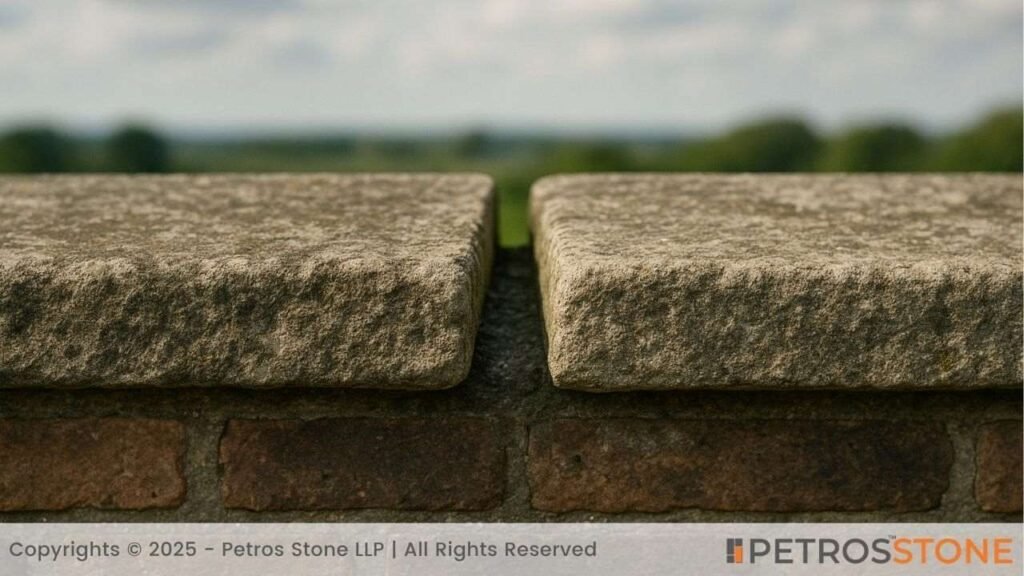
Because saddle-shaped, twice-weathered coping stones are widely preferred, they effectively direct water flow. These wall copings, which resemble hip roofs, have a central ridge that directs water in either direction and are inclined on both sides
Since the direction of water drainage is irrelevant, they are frequently utilized in balustrading and garden walls. Additionally, “drip grooves” could be added to the underside of the coping’s overhanging section to stop water from damaging the wall.
Twice-Weathered Coping Sizes
| STRAIGHT PIECE | OUTSIDE CORNER PIECE | MATERIAL | FINISHES | NOTES |
| Width – 300mm, 350mm, 400mm, 450mm, 500mm, 600mm | Available in matching widths | Natural Stone, Concrete | Sawn top surface, fettled or dressed edges | Central ridge with slopes on both sides; drip grooves optional; thickness 50mm-75mm |
| Thickness – 50mm, 75mm | ||||
| Length – 600mm, 900mm, 1000mm |
Sawn Coping
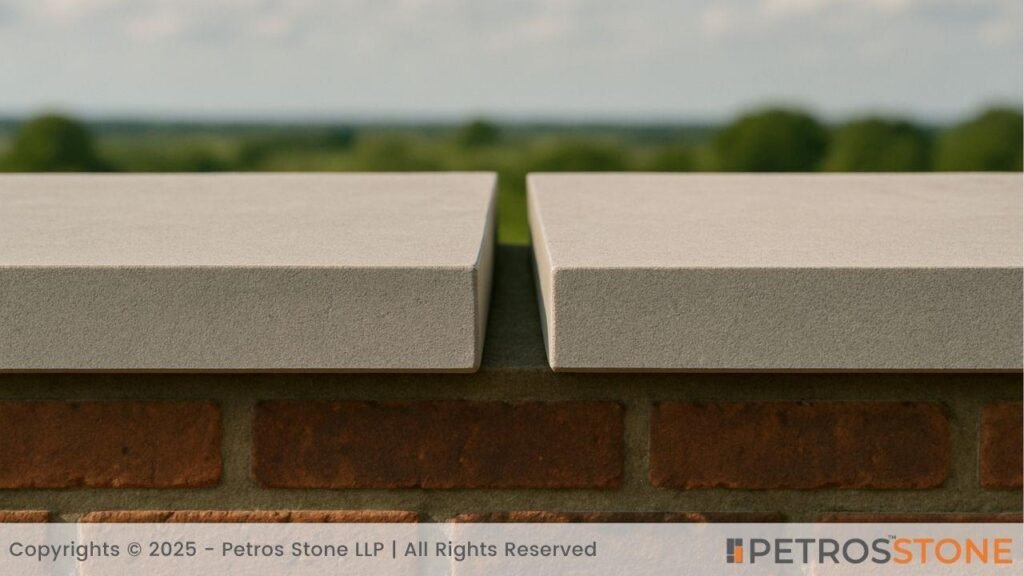
Six sides of sawn coping are sawn to provide a straight and smooth edge. This is typically 50 mm thick and comes in whatever width that is needed, as well as arbitrary lengths that range from
Sawn Coping Sizes
| STRAIGHT PIECE | OUTSIDE CORNER PIECE | MATERIAL | FINISHES | NOTES |
| Width – Customizable from 150mm up to 600mm | Can be custom-made upon request | Natural Stone | Sawn on all six sides, smooth modern finish | Typically 50mm thick; random lengths (600mm to 1000mm or longer on request) |
| Thickness – 50mm | ||||
| Length – Random 600mm – 1000mm+ |
Edge Coping (Dressed and Fettled)
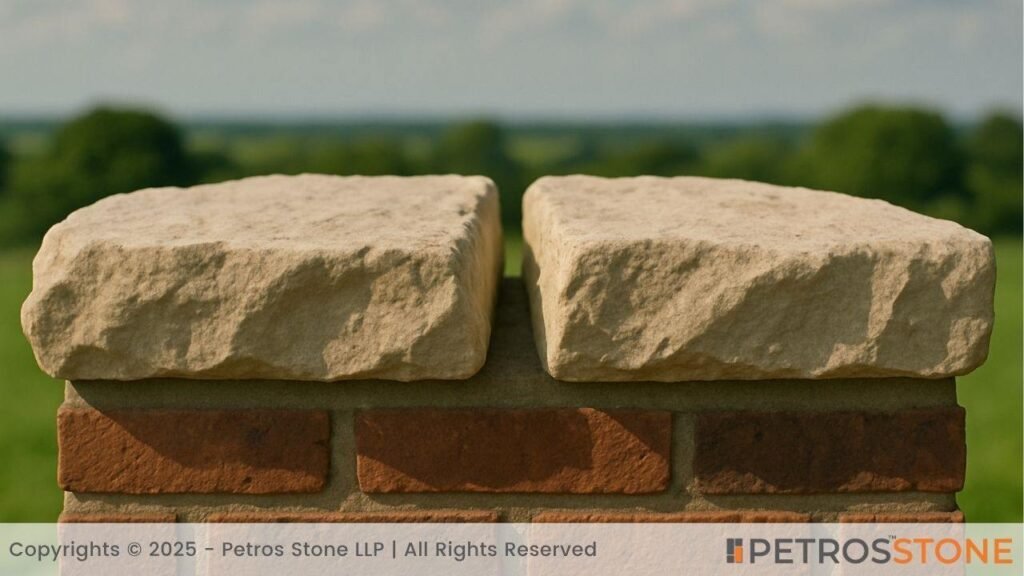
This features a sawn top and bottom face and has been hand-finished on the edges for a rougher, more traditional look. A ‘fettled’ edge is a rougher, more organic finish, whereas a dressed edge provides a consistent texture.
Edge Coping (Dressed and Fettled) Sizes
| STRAIGHT PIECE | OUTSIDE CORNER PIECE | MATERIAL | FINISHES | NOTES |
| Width – 300mm, 350mm, 400mm, 450mm, 500mm, 600mm | Available in matching widths | Natural Stone | Sawn top and bottom, hand-fettled or dressed edges | Traditional appearance; thickness 50mm-75mm; drip grooves optional |
| Thickness – 50mm, 75mm | ||||
| Length – 600mm, 900mm, 1000mm |
Riven Coping

Riven coping is made by hand, breaking stone along the bed, rather than being sawn, which results in an uneven and rough surface. For applications where you want an aged look, Riven Coping is fantastic. Coping is 300 mm broad by random lengths with a varied thickness ranging from 40 to 60 mm because the sizes available are considerably more limited due to the nature of this stone.
Riven Coping Sizes
| STRAIGHT PIECE | OUTSIDE CORNER PIECE | MATERIAL | FINISHES | NOTES |
| Width – 300mm (standard), limited widths | Limited availability | Natural Stone | Riven (natural split surface), rough texture | Hand-split finish; variable thickness 40mm-60mm; random lengths due to natural variation |
| Thickness – 40mm-60mm | ||||
| Length – Random 600mm – 1000mm |
Chamfered Coping
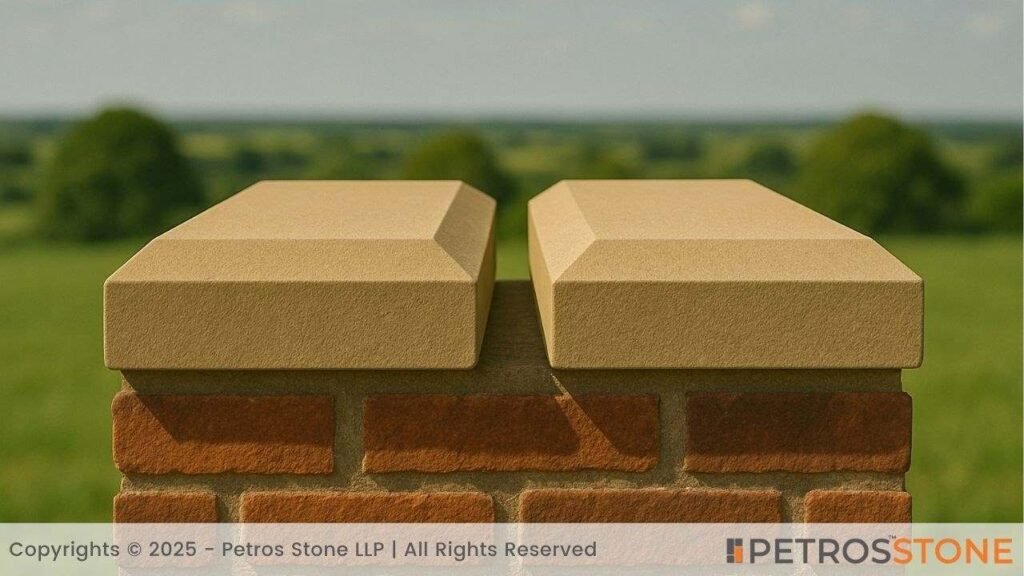
Chamfered coping is often thicker than ordinary sawn coping, measuring 75mm or 100mm, and is sawn on six sides. A chamfer creates a symmetrical sloping edge by cutting away a corner or right-angled edge.
Chamfered Coping Sizes
| STRAIGHT PIECE | OUTSIDE CORNER PIECE | MATERIAL | FINISHES | NOTES |
| Width – 300mm, 350mm, 400mm, 450mm, 500mm, 600mm | Available in matching widths | Natural Stone, Concrete | Sawn top and bottom, chamfered edges | Thickness 75mm or 100mm; modern symmetrical profile; drip grooves optional |
| Thickness – 75mm, 100mm | ||||
| Length – 600mm, 900mm, 1000mm |
Half Round Wall Tops

To give your wall a rounded top, utilize half-round wall tops. Our stonemason hand-dresses these in conventional widths of 12″-18″. If necessary, we may additionally provide in different widths.
Half Round Wall Tops Sizes
| STRAIGHT PIECE | OUTSIDE CORNER PIECE | MATERIAL | FINISHES | NOTES |
| Width – 300mm, 350mm, 400mm, 450mm (12″ to 18″) | Available in matching widths | Natural Stone | Hand-dressed, rounded top | Smooth rounded top; custom widths available upon request; standard length 600mm-900mm |
| Thickness – Typically 75mm-100mm | ||||
| Length – 600mm, 900mm |
Price Range for Coping Stones (in USD)
Coping stones vary significantly in price depending on the material, size, and finish. Here’s a general price guide:
- Concrete Coping Stones: $5–$15 per linear foot
- Brick Coping Stones: $8–$20 per linear foot
- Natural Stone Coping Stones: $15–$50 per linear foot
- Custom Sizes/Finishes: Additional costs depending on the stone and design complexity.
What size coping stones do I need?
Coping stones are available in a range of standard sizes. Typically, they are rectangular. There are lengths between 400 and 600 mm, widths between 150 and 450 mm, and thicknesses between 40 and 100 mm. The coping height is typically between 50 and 100 mm for twice-weathered types. Coping stones can weigh anything from a few kilograms to more than twenty kilograms.
Standard Sizes and Profiles
Coping stones come in various profiles. This includes molded, flat, and twice-weathered. The typical measurements for twice-weathered styles are 600 mm long, 150 mm wide, and 50 mm thick.
The standard dimensions for precast concrete coping stones are 300 x 600 x 40/50 mm and 300 x 600 x 75/100 mm. Additional sizes are available, such as 425 x 425 x 50/90 mm.
- General Dimensions
Coping stones usually come in 600mm (2-foot) lengths. The range of widths is 150 mm (6 inches) to 450 mm (18 inches) or beyond. The range of thicknesses is 40 mm (1.5 inches) to 100 mm (4 inches).
- Profiles
Molded, twice-weathered, and flat coping profiles are standard. The upper surface of twice-weathered copings slopes on both sides to divert water.
Selecting the Appropriate Size:
- Wall Width
The coping stone’s width should extend beyond the wall on both sides. Increasing the wall width by 25 mm (1 inch) on each side is a good idea.
- Wall Height
The coping stone’s height ought to match the wall’s height. Coping stones typically range in height from 50 to 100 mm.
- Aesthetics
The coping stone’s general appearance and texture should blend with the wall’s and the neighborhood’s design.
What’s the Best Coping Stone Material?
Concrete, brick, metal, and natural stone are some materials that can be used to make coping stones. They frequently include tiny grooves or channels to allow water to drain, and they are made to dangle slightly over the wall to keep water away from the wall below. Stones that can withstand hot conditions and effectively block UV radiation include granite, limestone, and sandstone. They work well for outside spaces, including pergolas, garden walls, backyards, and facades.
Natural Stone
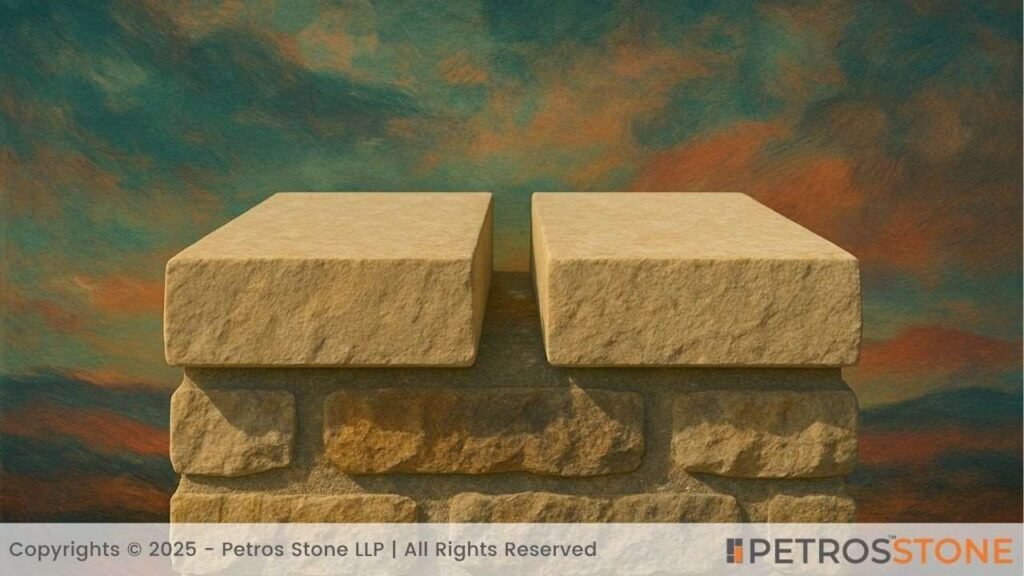
This option comes in various textures and hues and delivers a classic, opulent appearance. Sandstone and limestone are long-lasting options that go well with multiple landscaping designs.
For walls and structures with natural stone veneer, stone copings are frequently the best option. Their magnificence is unparalleled, even though they are more expensive than materials like clay or concrete.
Brick
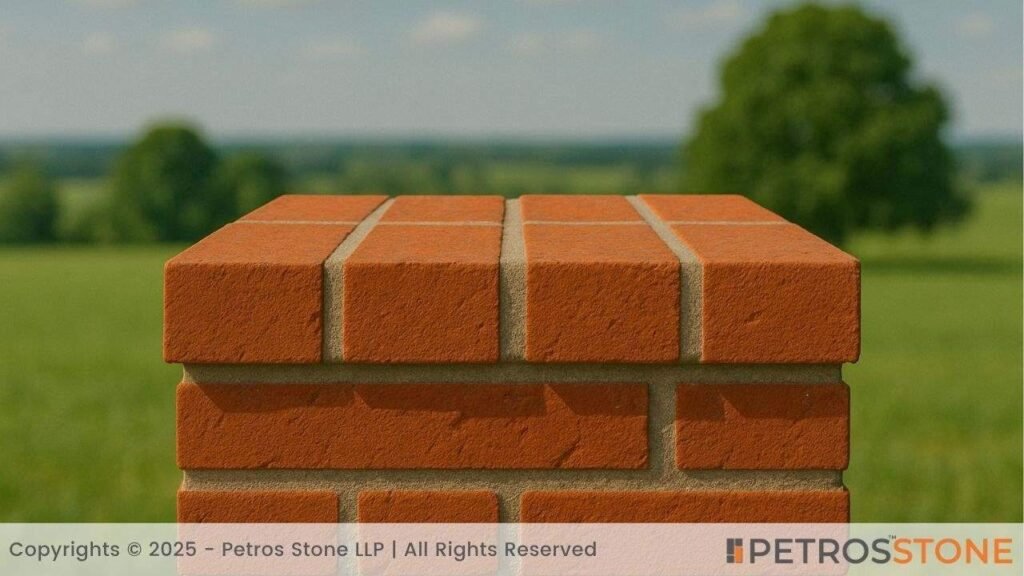
Brick copings typically match the wall underneath for a smooth appearance. Bricks, however, might not be the best material for copings because of their many joints, which increase the possibility of water seepage with poor construction.
The brick and mortar may deteriorate over time, leaving walls vulnerable to the weather. Brick copings require routine maintenance inspections because of their susceptibility; they are typically utilized on internal walls, such as privacy walls for rooftop terraces, rather than parapet walls. Consider applying brick copings to decorate non-parapet walls if you find them visually pleasing.
Concrete
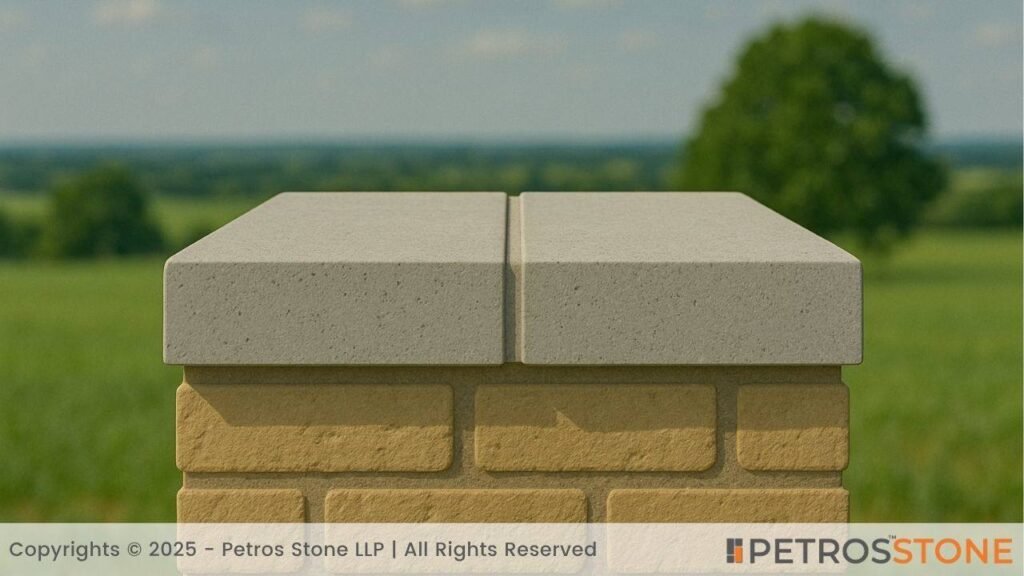
Concrete wall copings are more affordable than natural stone copings and other alternatives. Nevertheless, they are not appropriate for all types of walls because of their thickness and high weight, which calls for caution.
These copings, which are often installed on load-bearing, robust masonry walls, are available in various hues thanks to pigments in the mix, giving designers and builders a wide range of style options.
Ceramics

They are perfect for a wall because of their nearly impermeable composition, which minimizes water infiltration. Because porcelain is not porous, it also helps to resist stains, so the coping will remain low maintenance and retain its original color over time.
Applications of Coping Stones
Coping stones serve multiple purposes across various construction and landscaping contexts. Below are the primary applications, each with specific requirements for coping types and sizes –
Garden Walls
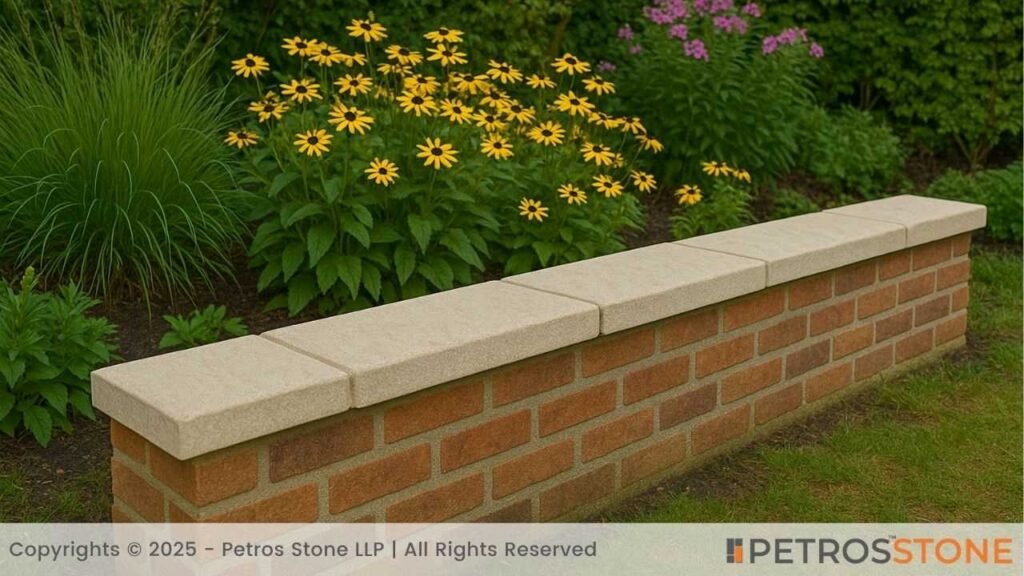
- Environment – Exposed to weather, requiring robust materials and water-shedding designs.
- Types Used – Once-weathered, Twice-weathered, Flat, Riven, Half Round, Chamfered, Edge Dressed/Fettled.
Parapet Walls
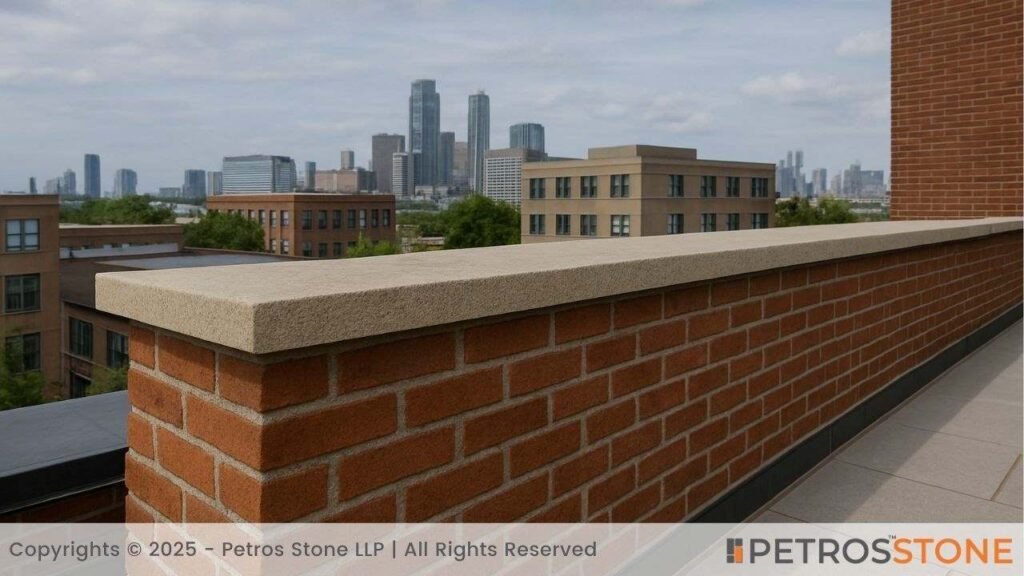
- Environment – High exposure to rain and wind, often on taller structures.
- Types Used – Once-weathered, Twice-weathered, Chamfered, Flat.
Pool Coping
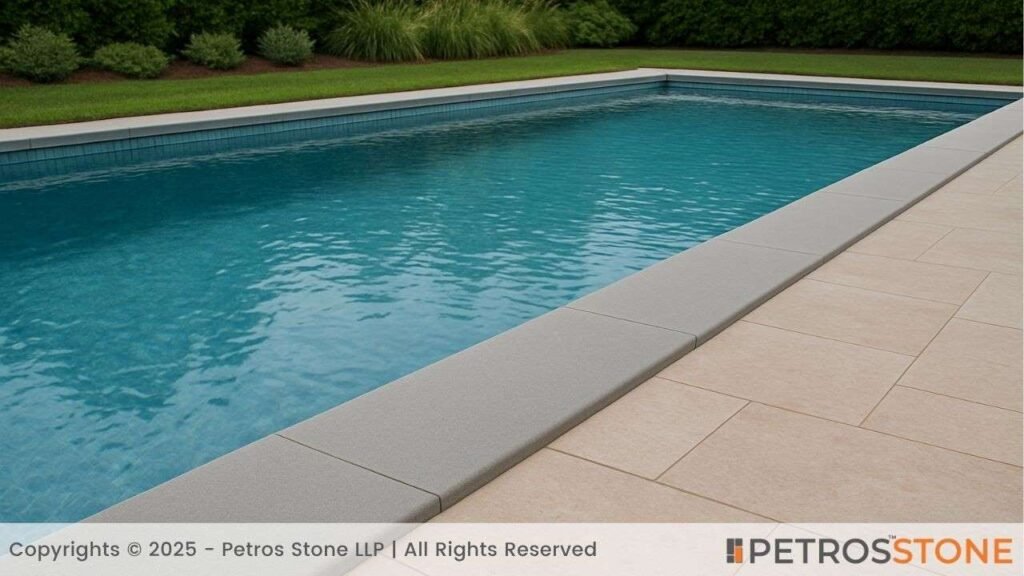
- Environment – Wet, high-traffic areas requiring slip-resistant finishes.
- Types Used – Flat, Chamfered, Sawn.
You can get exhaustive information on Pool Coping along with the cost estimation.
Balustrades
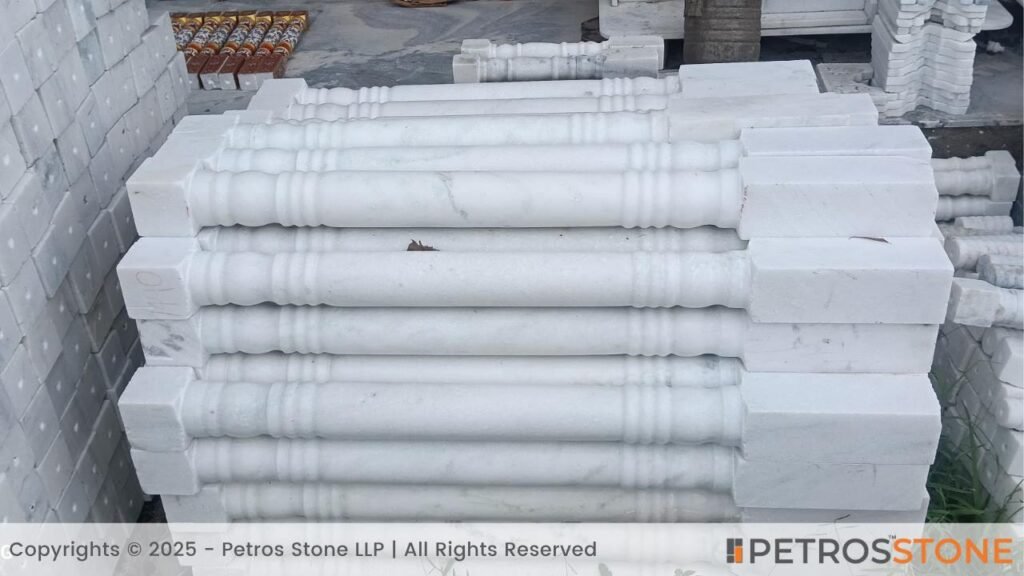
- Environment – Exposed to elements, often ornamental.
- Types Used – Twice-weathered, Half Round, Flat, Edge Dressed/Fettled.
Retaining Walls
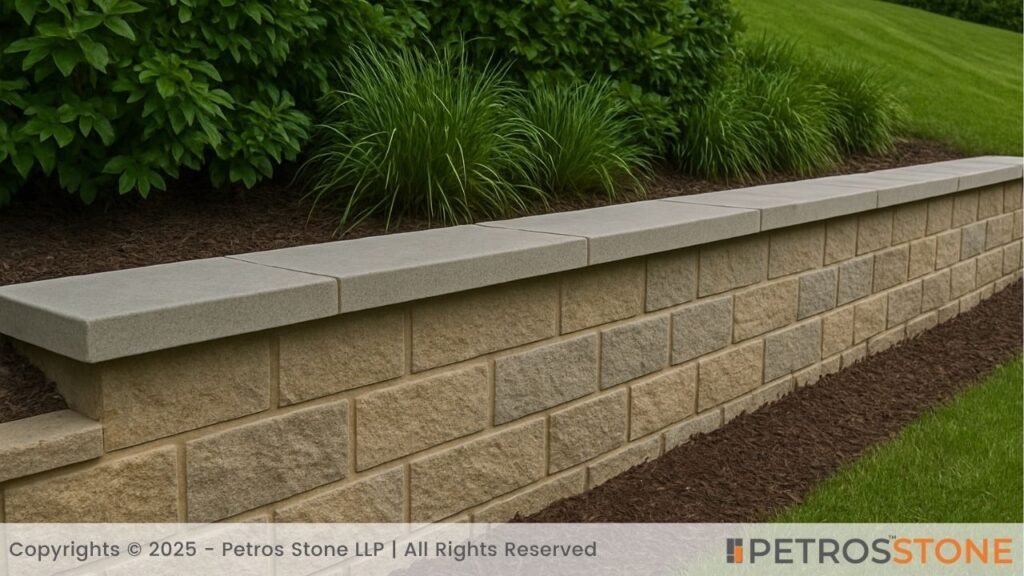
- Environment – Subject to soil pressure and moisture.
- Types Used – Once-weathered, Twice-weathered, Flat, Chamfered.
Lawn Edging
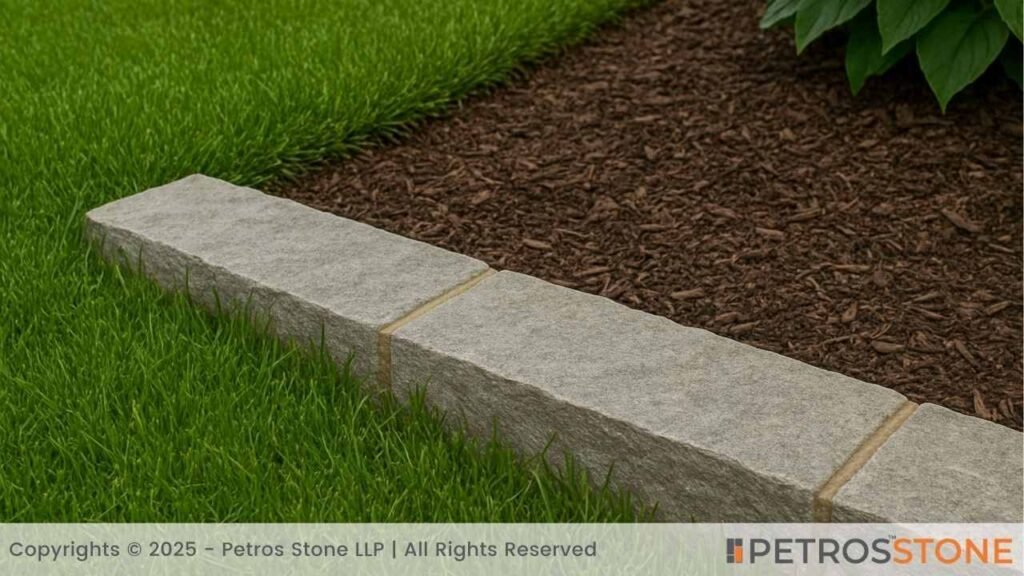
- Environment – Ground-level, moderate exposure to weather.
- Types Used – Flat, Riven, Edge Dressed/Fettled.
Pier Caps
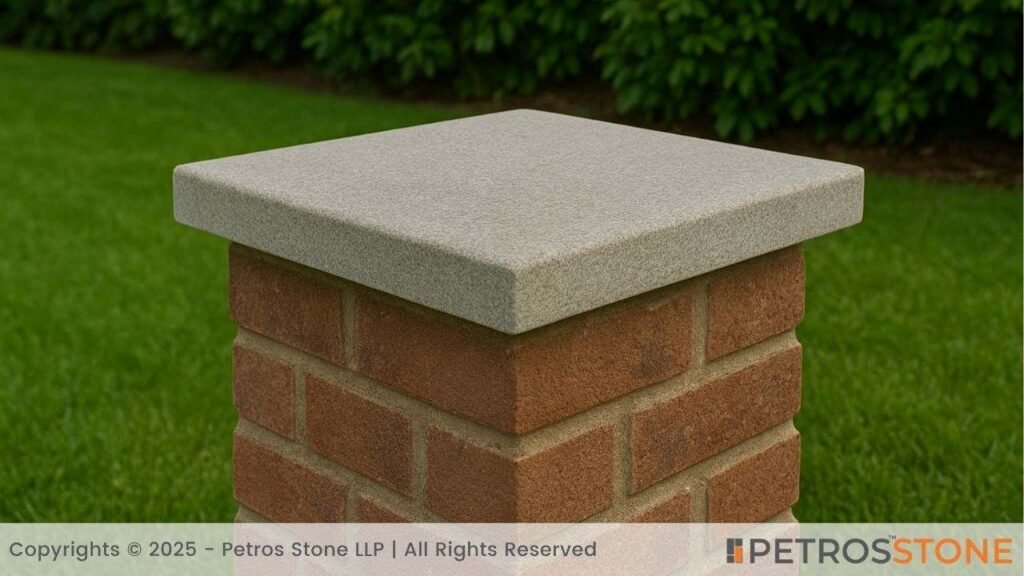
- Environment – Exposed, often standalone features.
- Types Used – Flat, Chamfered, Half Round.
How to Choose the Right Coping Stones for Your Property?
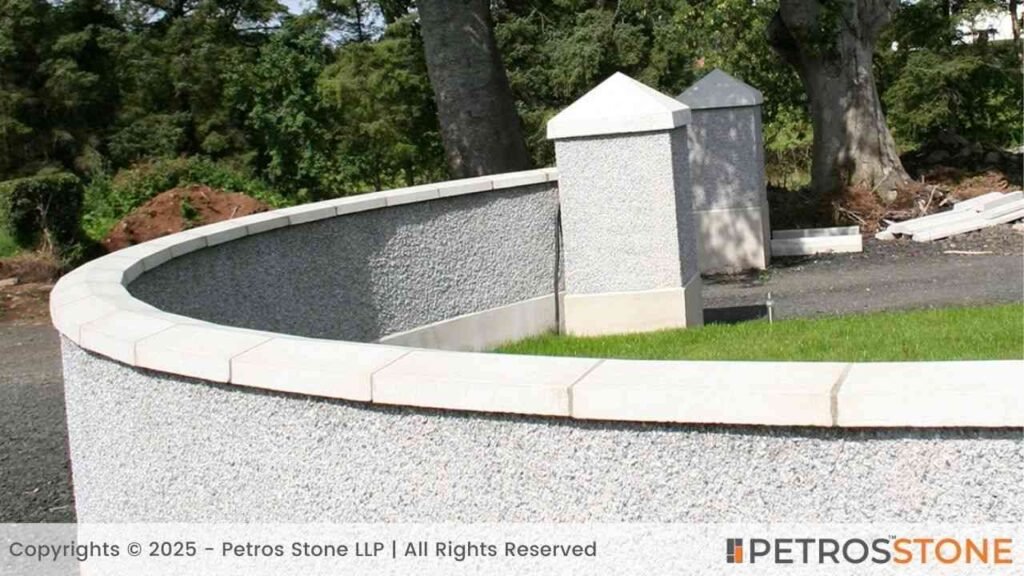
The style of your home, the architecture of your property, and the overall architectural aesthetic you want to achieve are all essential considerations when choosing the perfect coping stones for your property. When choosing coping stones for your property, follow these steps:
- Coping stones are used for both practical and decorative purposes. First, consider the purposes of wall coping stones, such as protecting your property from water damage or improving its attractiveness.
- Several types of wall coping stones exist, such as clay, concrete, and natural stone. Consider each alternative’s durability, texture, and color because every material has different qualities.
- Coping stones come in various styles, from modern to classic. First, choose a coping stone that goes well with the style of your house. For instance, sleek, contemporary coping stones might look good in a modern home, but more elaborate or conventional forms might look better in a traditional one.
- Coping stones are available in a variety of forms and sizes. Select a body that matches the architectural style of your wall or structure and a size that fits its width.
- Certain coping stones need to be cleaned and sealed regularly. Select a wall coping stone that suits your budget and is simple to maintain.
- Lastly, while choosing a coping stone, consider your budget. Natural stone could be more costly, but it might give the space a more luxurious and genuine appearance. Coping stones made of clay and concrete could be less expensive.
Care and Installation Guidelines

Protecting Your Coping
One of the most common questions is whether coping stones must be sealed. Although our cast stone items are naturally resistant to weather, sealing offers important extra security. This is why sealing is essential:
Improved Protection
A high-quality sealer adds another line of defense against environmental deterioration and moisture intrusion.
Increased Durability
Sealed coping stones usually endure longer and keep their aesthetic appeal better over time.
Easier Maintenance
Over time, sealed surfaces save you time and effort since they are simpler to clean and maintain.
Overhang
Overhang is not only a decorative option but also an essential practical component of installing coping stones. We usually advise an overhang of 30 to 40 mm on either side for best results. This is why overhang is important:
A suitable overhang keeps water from dripping and damaging the wall by ensuring that it drips clear of the wall face. This straightforward design element is essential for preventing erosion and water damage to the complete wall construction.
Upkeep and Attention
Your coping stones will continue to function well with regular maintenance. We advise a visual examination of your coping stones every three months, with particular focus on:
- Integrity of joints
- Indications of water intrusion
- State of the surface
FAQs
Do You Need Coping Stones?
Coping stones are a sensible and practical requirement in practically every walling job. They give you a visually appealing “capping” feature that diverts rainfall from underneath surfaces to protect a wall’s otherwise exposed exterior face.
Do Coping Stones Need to Be Used on Every Brick Wall?
Coping stones are more than a beautiful element; they prevent weathering, water damage, and runoff from rainwater on free-standing walls, garden walls, parapet upstands, boundary walls, and flat roof walls.
Should Coping Stones Overhang?
Most coping stones should have a 25–35 mm overhang on either side to shield the underlying wall from rainfall runoff.
Does Coping Stones Require Mechanical Repair?
We advise that you mechanically fasten your coping stones to the underlying wall if they are being erected at a height in a roofing project or an above-the-head walkway. When compared to ordinary ground-level fixing methods, this will offer the most dependable and secure fixing option since the brackets, plugs, screws, and fasteners form a safer interior fixing that is unlikely to succumb to wind uplift or deterioration.
What Distinguishes Single Weathered From Twice Weathered?
For water drainage, single-weathered coping stones have a single-sided slope. Dual-sided water drainage is accommodated by the two slopes of twice-weathered coping stones.
Feel free to get in touch for a free consultation, quote, and get a detailed understanding from our experts here at Petros®. Visit https://petrosstone.com/ or call +91-8446360361 and WhatsApp
Brown Granite
White Galaxy Granite
Blue Bahia Granite
Silver Cloud Granite
Black Pearl Granite
Dallas White Granite


